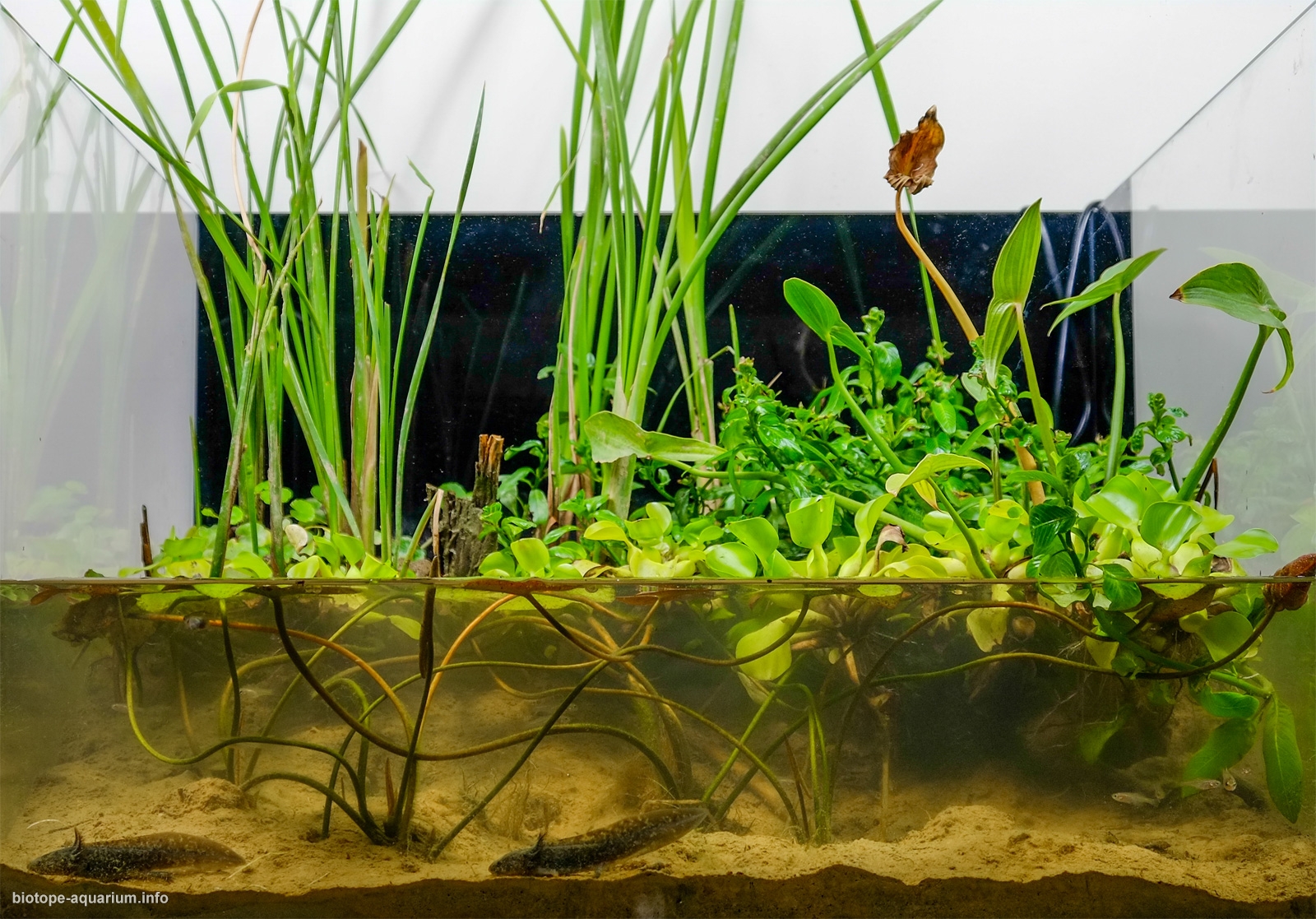Lake Xochimilco, Borough of Xochimilco in southern México City
51st place in Biotope Aquarium Design Contest 2017
![]() Taiwan. Newt Jhuang
Taiwan. Newt Jhuang

Volume: 162 L
Dimensions: 60x60x45 cm
List of fishes: Ambystoma mexicanum, Girardinichthys viviparous
List of plants: Ludwigia peploides, Nymphaea mericana, Eichhornia crassipes, Hydrocotyle ranunculoides, Typha domingensis
Description of decorations: Soil, wood, and small cobble
Description of equipment: Chiller, flow pump 2.1W, 2.8L/min, LED lamps 35.7W, 3717L/m
Water parameters: Temperature is 20℃, pH is 8.0
Description of the area surrounding the biotope: The five lakes within the Valley of Mexico have now largely disappeared, drained to reduce flooding. Only the Xochimilco canals remain from the original Lake Xochimilco. Even today, some chinamperos still work their chinampa gardens between the canals. Lake Xochimilco was the last remaining native habitat for axolotl, a species of mole salamander endemic to Mexico. Until Lake Chalco was drained, the species had also been present there. Given Lake Xochimilco’s present extensively compromised and reduced state, and the accelerating impact of Mexico City’s urban growth, as of 2008 axolotl in the wild are listed as a critically endangered species by the IUCN. In February 2014 it was disclosed that a survey in 2013 had failed to find any remaining specimens in the wild.
Description of the underwater landscape of the biotope: The ecosystem used to be a lake, and even though it has now become a canal, its stream bed is mainly composed of soil.
Description of the parameters of the habitat:
Temperature 19.5-22°C. The Secchi transparency was also low ranging between 0.18-0.4 m. The conductivity was low as can be expected in a freshwater body. pH 6.9-9.5. COD ranged between 80-135 mg/L.
List of fishes: Ambystoma mexicanum, Girardinichthys viviparous, Cambarellus montezumae, Chirostoma humboldtianum
List of plants: Ludwigia peploides, Nymphaea mericana, Pistia stratiotes, Eichhornia crassipes, Nymphaea odorata, Hydrocotyle ranunculoides, Lilaeopsis schaffneriana, Ranunculus cymbalaria, Typha latifolia, Typha domingensis, Spiranthes Graminea, Juncus liebmann, Juncus microcephalus, Juncus tenuis, Sagittaria latifolia et al.
Threats to the ecology: Most species of Lake Xochimilco on Mexican Plateau are mostly of foreign origin, such as Tilapia and carps. With the addition of agricultural and industrial waste water, Lake Xochimilco’s water has undergone eutrophication, resulting in great reduction of numbers of wild Girardinichthys viviparous and Ambystoma mexicanum in the lake. It is currently unknown if G. viviparous still exists in Lake Xochimilco. Furthermore, some sources has pointed out G. viviparous might have gone extinct in the lake. As a result, IUCN has listed it as a critically endangered species.
Sources of information:
- https://www.mexfish.info/species.php?id=19
- https://books.google.com.tw/books?id=hIwbDAAAQBAJ&pg=PA308&lpg=PA308&dq=lake%20xochimilco%20plants&source=bl&ots=pmLH1TDjeh&sig=cmaYCxao_t-HIS8ygcxVbZeKVOA&hl=zh-TW&sa=X&ved=0ahUKEwjbn_CxkJbWAhXIEpQKHY7kAM44ChDoAQhOMAU#v=onepage&q=lake%20xochimilco%20plants&f=false
- https://science.mnhn.fr/institution/mnhn/collection/p/item/p00752286?listIndex=11&listCount=2578
- http://doczz.es/doc/5385619/zona-lacustre-%E2%80%9Cejidos-de-xochimilco-y-san-gregorio-atlapu
- https://books.google.com.tw/books?id=xgjVwriZSs8C&pg=PA28&lpg=PA28&dq=ludwigia%20Xochimilco&source=bl&ots=sWyw_wdNXv&sig=hk9i6CQy3yJyBrDu6pvsK4j1rL0&hl=zh-TW&sa=X&ved=0ahUKEwjy2PDGkZXWAhXHULwKHVRSBj8Q6AEISjAK#v=onepage&q=ludwigia%20Xochimilco&f=false
- https://i.guim.co.uk/img/static/sys-images/Guardian/Pix/pictures/2015/4/16/1429178851528/The-Chinampas-floating-ga-009.jpg?w=1920&q=55&auto=format&usm=12&fit=max&s=b07462e5f1fb55dfe88de724446e50f6
- https://books.google.com.tw/books?id=hvS5xljxuL4C&pg=PA274&lpg=PA274&dq=sagittaria%20%20xochimilco&source=bl&ots=7YzW5dqJL_&sig=IlbYapz-LOac5WSJQGO-FNsusNo&hl=zh-TW&sa=X&ved=0ahUKEwisrtSfoZbWAhWBsJQKHTtlBFkQ6AEINjAG#v=onepage&q=sagittaria%20%20xochimilco&f=false
- http://www.goodeidworkinggroup.com/girardinichthys-viviparus
Comments of the members of the jury of Biotope Aquarium Design Contest 2017

It is an aquarium with good conditions for semi-aquatic plants. But we should not forget about the underwater inhabitants. Fishes, as a result, will be eaten by axolotls.
